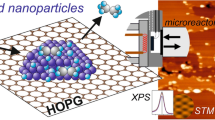Abstract
Systematic studies of adsorption of hydrogen and carbon monoxide on polycrystalline surfaces of nickel and cobalt have been carried out. The aim of these studies was to gain a better insight into the catalyzed formation of hydrocarbons from H2-CO mixtures. We have studied the adsorption of these gases by means of thermal desorption spectroscopy (TDS) on nickel foils and powders. More recently, we have obtained desorption spectra of hydrogen adsorbed on cobalt foils and powders. In this work we described desorption spectra of carbon monoxide on cobalt foils. Carbon monoxide desorption from cobalt foils was studied in a similar way as prior work, using a mass spectrometric method in an ultra high vacuum system. Two carbon monoxide desorption peaks were observed. These two states correspond to molecular CO and presumably dissociated CO, as it is observed in the case of stepped surfaces of Ni and Co single crystals. An activation energy of around 4.0 kcal/mol is obtained for the molecular state while for the dissociated state the energy is coverage-dependent with a value between 8.0 and 15.0 kcal/mol. The carbon monoxide desorption peaks were fitted with near Gaussian curves which facilitates the analysis of the data to obtain activation energies for desorption. Kinetic parameters for carbon monoxide and hydrogen desorption from nickel and cobalt foils are provided and compared with already published data involving single crystals.
Similar content being viewed by others
References
M.A. Vannice, J. Catal. 37 (1975) 449.
G.A. Somorjai, Catal. Rev.-Sci. Eng. 23 (1981) 189.
C.A. Luengo, A.L. Cabrera, H.B. MacKay and M.B. Maple, J. Catal. 47 (1977) 1.
A.L. Cabrera, J. Vac. Sci. Technol. A 8 (1990) 3229.
J.N. Russel Jr., S.M. Gates and J.T. Yates Jr., J. Chem. Phys. 85 (1986) 6792.
G. Wedler, G. Fish and H. Papp, Ber. Bunsenges. Phys. Chem. 74 (1970) 186.
K. Christmann, O. Schober, G. Ertl and M. Neumann, J. Chem. Phys. 60 (1974) 4528.
A.L. Cabrera, J. Vac. Sci. Technol. A 11 (1993) 205.
A.L. Cabrera, E. Morales, L. Altamirano and P. Espinoza, Rev. Mex. Fis. 39 (1993) 1099.
A.L. Cabrera, J. Vac. Sci. Technol. A 7 (1989) 2681.
H. Papp, Surf. Sci. 149 (1985) 460.
D.W. Goodman, J.T. Yates Jr. and T.E. Madey, Surf. Sci. 93 (1980) L135.
J. Lauterbach, M. Wittmann and J. Kuppers, Surf. Sci. 279 (1992) 287.
J.J.C. Geerlings, M.C. Zonnevylle and C.P.M. de Groot, Surf. Sci. 241 (1991) 315.
A.L. Cabrera, J. Chem. Phys. 93 (1990) 2854.
M.A. Van Hove and K. Hermann, Surface Architecture and Latuse, A PC-based program, Version 2.0, Lawrence Berkeley Lab., Berkeley, CA (1988).
J.M. MacLaren, J.B. Pendry, P.J. Rous, D.K. Saldin, G.A. Somorjai, M.A. Van Hove and D.D. Vvedensky,Surface Crystallographic Information Service: A Handbook of Surface Structures (Reidel, Dordrecht, 1988) p. 327.
Author information
Authors and Affiliations
Rights and permissions
About this article
Cite this article
Cabrera, A.L., Garrido M, W.H. & Volkmann, U.G. Studies of carbon monoxide and hydrogen adsorption on nickel and cobalt foils aimed at gaining a better insight into the mechanism of hydrocarbon formation. Catal Lett 25, 115–126 (1994). https://doi.org/10.1007/BF00815421
Received:
Accepted:
Issue Date:
DOI: https://doi.org/10.1007/BF00815421




